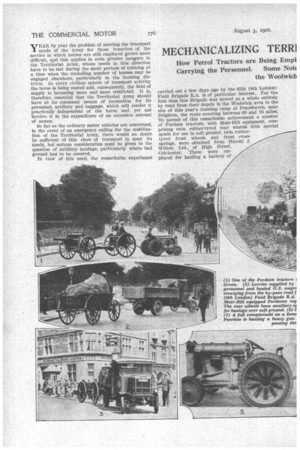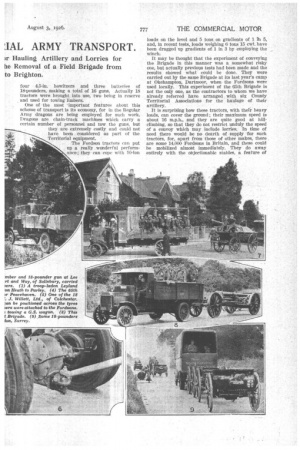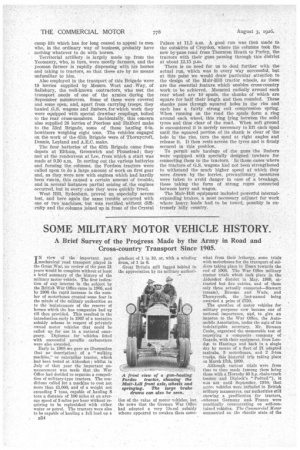ATEAR by year the problem of meeting the transport needs
Page 16

Page 17

Page 18

If you've noticed an error in this article please click here to report it so we can fix it.
of the Army for those branches of the service in which horses are still employed grows more difficult, and this applies in even greater meafure to the Territorial Army, whose needs in this direction have to be met during the short periods of training at a time when the dwindling number of horses may be engaged elsewhere, particularly in the farming districts. In every civilian sphere of transport activity the horse is being ousted and, consequently, the field of supply is becoming more and more restricted. It is, therefore, essential that the Territorial Army should have at its command means of locomotion for its personnel, artillery and baggage, which will render it practically independent of the horse. and yet not involve it in the expenditure of an excessive amount of money.
So far as the ordinary motor vehicles are concerned, in the event of an emergency calling for the mobilization of the Territorial Army, there would no doubt be sufficient of this class of transport to meet its needs, hut serious consideration must be given to the question of artillery haulage, particularly where bad ground has to he covered.
In view of this need, the remarkable experiment carried out a few days ago by the 65th (8th London) Field Brigade R.A. is of particular interest. For the first time this Brigade was moved as a whole entirely by road from their depots in the Woolwich area to the site of this year's training camp at Peacehaven, near Brighton, the route covering between 60 and 70 miles. To permit of this remarkable achievement a number of Fordson tractors, with Muir-Hill equipment, comprising twin rubber-tyred rear wheels with special spuds for use in soft ground, twin rubbertyred front wheels and front crosssprings, were obtained from Harold J. Willett, Ltd., of High Street, Colchester. These were employed for hauling a battery of four 4.5-in, howitzers and three batteries of 18-pounders, making a total of 16 guns. Actually 18 tractors were brought into use, two being in reserve . and used for towing limbers.
One of the most -important features about this scheme of transport is its economy, for in the Regular Army dragons are being employed for such work. Dragons are chain-track machines which carry a certain number of personnel and tow the guns, but they are extremely costly and could not have been considered as part of the Territorial equipment.
The Fordson tractors can put up a really wonderful performance; they can cope with 10-ton
loads on the level and 5 tons. on gradients of 1 Pn 5, and, in recent tests, loads weighing 6 tons 15 cwt. have been dragged up gradients of 1 in 3 by employing the winch.
It may be thought that the experiment of conveying the Brigade in this manner was a somewhat risky one, but actually previous tests had been made and the results showed what could be clone. They were carried out by the same Brigade at its last year's camp at Okehampton, Dartmoor, when the Fordsons were used locally. This experiment of the 65th Brigade is• not the only one, as the contractors to whom we have already referred have arranged with six County Territorial Associations for the haulage of their artillery.
It is surprising bow these tractors, with their heavy loads, can cover the ground ; their maximum speed is about 16 m.p.h., and they are quite good at hillclimbing, so that they do not restrict unduly the speed of a convoy which may include lorries. In time of need there would be no dearth of supply for such tractors, for, apart from those of other makes, there , are some 14,000 Fordsons in Britain, and these could be mobilized almost immediately. They do away entirely with the objectionable stables, a feature of camp life which has for long ceased to appeal to men vvbo, in the ordinary way of business, probably have nothing whatever to do with horses.
Territorial artillery is largely made up from the Yeomanry, who, in turn, were mostly farmers, and the yeoman farmer is rapidly dispensing with his horses and taking to tractors, so that these are by no means unfamiliar to him.
Also employed in the transport of this Brigade were 18 lorries supplied by Messrs. Wort and Way, of Salisbury, the well-known contractors, who met the transport needs of one of the armies during the September manceuvres. Some of these were covered and some open, and, apart from carrying troops, they hauled G.S. wagons and limbers, for which work they were equipped with special drawbar couplings, bolted to the rear cross-members. Incidentally, this concern also supplied 26 lorries of Peerless and Ha'ford make to the 53rd Brigade, some of these hauling 6-in. howitzers weighing eight tons. The vehicles engaged on the work of the 65th Brigade were of Thornycroft, Dennis, Leyland and A.E.C. make.
The four batteries of the 65th Brigade came from depots at Eltham, Greenwich and Plumstead ; they met at the rendezvous at Lee, from which a start was made at 9.30 a.m. In sorting out the various batteries and forming the columns, the Fordson tractors were called upon to do a large amount of work on first gear and, as they were new with engines which had -hardly been run-in, this caused a certain amount of trouble, and in several instances partial seizing of the engines occurred, but in every case they were quickly freed.
West Hill, Sydenham, proved an especially severe test, and here again the same trouble occurred with one or two machines, but was rectified without difficulty and the columns joined up in front of the Crystal Palace at 11.5 a.m. A good run was then made to the outskirts of Croydon, where the columns took the new by-pass road from Thornton Heath to Purley, the tractors with their guns passing through this district at about 12.15 p.m.
There is no need for us to deal further with the actual run, which was in every way successful, but at this point we would draw particular attention to the 'design of the Muir-Hill tractor wheels, as these are the essential feature which enables cross-country work to be achieved. Mounted radially around-each rear wheel are 10 spuds, the shanks of which are square for half their length and then rounded. These shanks pass through squared holes in the rim and each has a fairly strong coil compression spring. When running on the road the spuds form a ring around each wheel, this ring lying between the solid tyres and thus clear of the road. When soft ground is encountered it is merely necessary to lift each spud until the squared portion of its shank is clear of the hole in the rim, turn the spud at right angles and release it. It then rests across the tyres and is firmly secured in this position.
To permit safe haulage of the guns the limbers were equipped with specially designed towbars for connecting them to the tractors. In those eases where the tractors of G.S. wagons had not been strengthened to withstand the much higher speed at which they were drawn by the lorries, precautionary measures were taken to avoid danger in case of a breakage, these taking the form of strong ropes connected between lorry and wagon.
The Muir-Hill equipment included powerful internalexpanding brakes, a most necessary adjunct for work where heavy loads had to be towed, possibly in extremely hilly country.






























